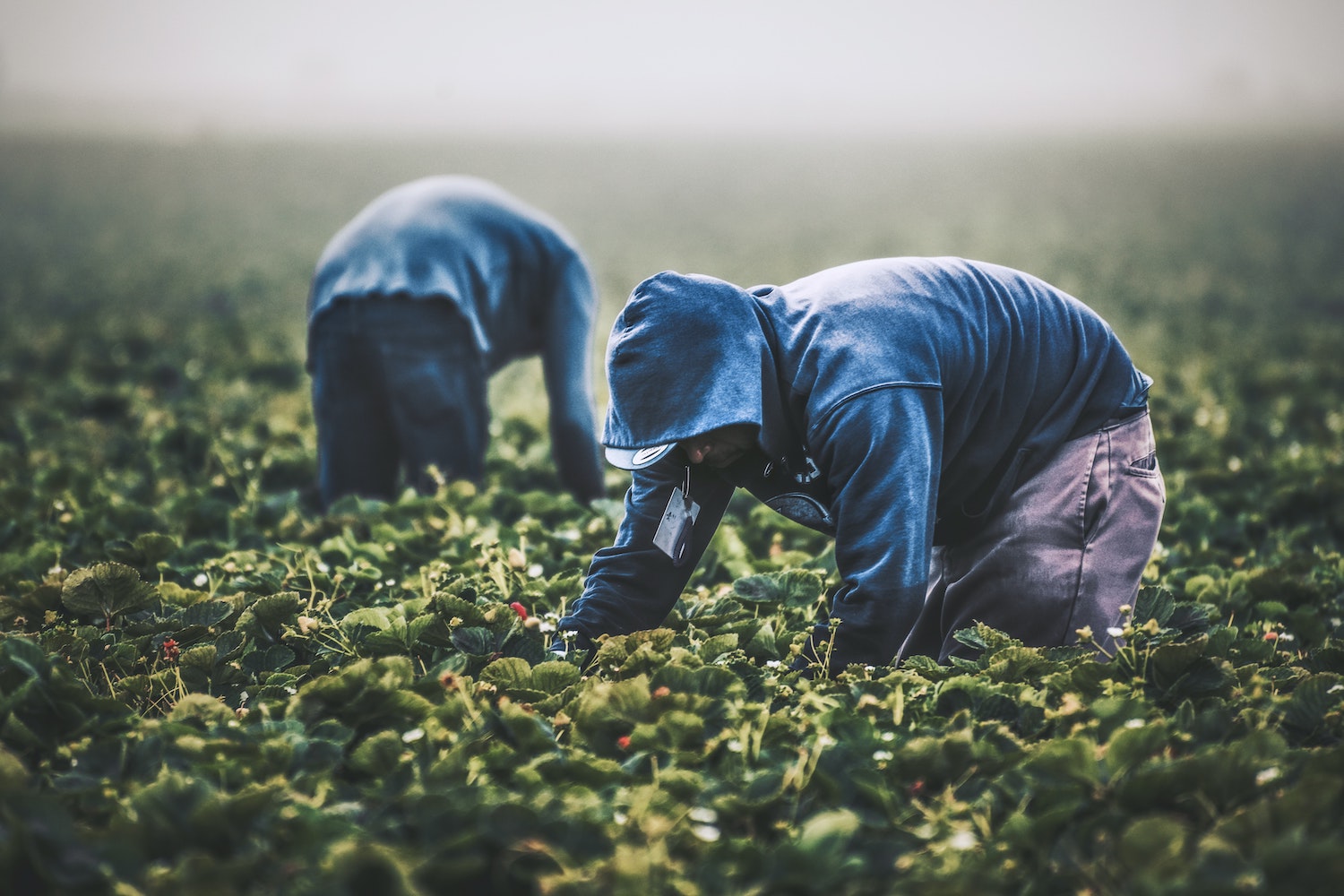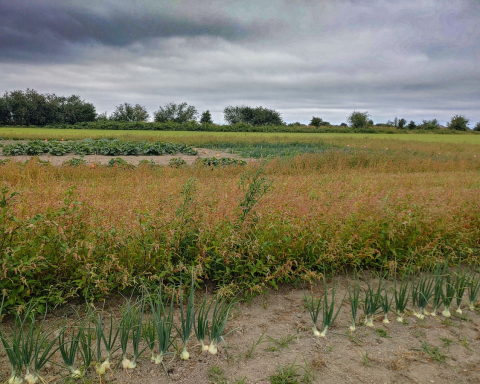By the National Farmers Union
For decades, Canada’s farm numbers have been going down, farm size has been increasing, and more farms have come to rely on hired workers as a consequence. The ongoing loss of farms and the current shortage of farm labour have the same root cause: a cost-price squeeze that results in inadequate returns to the work of farming, whether done by the farm operators or farm workers. Paying high prices for inputs and receiving low prices for commodities results in farmers subsidizing their farms with off-farm jobs, pressure to keep wages to farm workers low, the exit of skilled people from the sector to pursue more remunerative and less precarious sources of income, and a lack of new entrants to replace retiring farmers.
Yet, there are many young people who would like to make farming their life’s work. They are interested in having good jobs on farms and/or operating their own farms. Canada is a wealthy country and has the ability to ensure they have rewarding careers—if we have an Agricultural Labour Strategy that is designed to ensure farm labour is properly compensated, safe, and dignified.
We reject a view that seeks to reduce labour costs by maximizing the use of technology (robots, automation, self-driving tractors, etc.) and adopting a “just-in-time” approach to the employment of Temporary Foreign Workers (TFWs). Canada’s National Agricultural Labour Strategy must recognize the full humanity of farmers and farm workers, the role and meaning of work in their lives, and the multiple contributions to a healthy society that result from the dignity of work. In other words, the people who work on their own farms or as employees on farms are not merely “productive units” that enable input companies, commodity traders, and food processors to maximize their profits.
The crisis in farm labour goes beyond a labour shortage that threatens Canada’s food production capacity. It is also an alarm bell for Canada to heed before we lose the essential skills and knowledge carried by the people who do the work of agriculture.
We in the NFU believe we need an Agriculture Labour Strategy that respects and values the work of farming—whether it is done by farmers or farm workers.
Are labour shortages having a negative impact?
The failure of the agri-food sector to provide returns to labour has resulted in a loss of farms, and an inability of the agriculture and agri-food sector to reliably attract and retain needed workers. This worsens the farm income crisis, accelerates rural depopulation, and contributes to a decline in the quality of life for rural residents. These factors drive a vicious circle of decline. When farmers on small and mid-sized sustainable farms are unable to secure a liveable income, they are unable to hire farm workers at competitive wages. The long-term loss of farmers depletes the pool of local people with the required skills. Retired farmers have become an important but time-limited source of labour on the prairies where farm size has increased dramatically. If and when there is nobody available to hire, work goes undone, resulting in higher risks, more farm stress, lower production, higher costs, and lower incomes. A lack of labour also inhibits farms from adopting or continuing practices that are better for the land but take more time.
Labour shortages also mean existing workers (including farm owners) work for longer hours and must cover a wider range of tasks. The strain that results often induces undercompensated, skilled farm workers to leave the sector, further worsening the loss of farm productivity.

Has the supply and demand related to agricultural workers changed in recent years?
With the exception of the supply managed sectors, Canada’s agriculture markets are structured to keep prices paid to farmers as low as possible. This is due primarily to the monopoly power of the main agri-business corporations purchasing commodities, and is reinforced by trade agreements and export policies that require Canadian products to compete at home and abroad with those produced in countries with much lower wage rates and weaker labour standards. The “demand” for labour is tightly linked to the ability to pay, thus the leakage of Canada’s food dollars to multinational corporations elsewhere reduces the amount of revenue available in our own food system that could support a larger number of farmers and farm workers.
The supply of agricultural labour in Canada is constrained by low wages and working conditions, discouraging young people from pursuing agricultural careers. While trade agreements allow Canada to easily import low-priced agricultural products, workers’ mobility to come here, and to move within Canada, is tightly controlled at the border and by the rules governing TFWs. In addition, the restrictions on TFW mobility and their lack of rights contribute to the undervaluing of farm labour across the board.
How can we help keep workers in the agriculture and agri-food sector, and better support the recruitment and retention of under-represented groups?
Many farm workers are racialized and/or are from disadvantaged communities that are under-represented in better-paying sectors of the economy. The Farm Labour Strategy needs to increase equity within the sector, and between agriculture and other sectors of the economy, with policies that ensure both farmers and farm workers are able to earn livable incomes.
All farm workers in Canada should have the coverage they need under provincial and territorial labour laws, including the right to associate and form a union.
All TFWs in agriculture should be entitled to permanent residency status. Many TFWs have been coming to Canada seasonally for over 30 years. If we want to keep these workers in the agriculture and agri-food sector and attract even more high-calibre, skilled foreign workers, we need to ensure they have access to and can benefit from all the rights and protections afforded to Canadian workers.
Globalization has entrenched an imbalance between farm product prices and the living wage level required for farm workers in Canada. A Basic Income Guarantee and/or changes to the Employment Insurance (EI) system are needed to address this problem. The EI system should recognize the seasonality of agriculture work and the need for a year-round livable income for farm workers. With a liveable year-round income, people employed as farm workers could continue the essential task of growing food for Canadians without worry of seasonal income loss, climate change disruptions (drought, fires, etc.) and without increasing food costs for consumers.
Improving Business Risk Program design to ensure labour intensive operations have adequate support and a Guaranteed Basic Income program that takes into account the specifics of agricultural work should be explored so that all agricultural producers can continue the essential task of growing food for Canadians.
In addition to low wages, our farm worker members consistently voice how a lack of quality, affordable, and conveniently-located housing is a major deterrent for remaining in the sector. Canada must invest in rural public housing; rural schools; rural public transit; and child-care facilities. More investment in rural health care and more affordable access for both farm operators and farm workers to supplementary health and dental benefits and workers’ compensation insurance is also needed.
Small and medium enterprises in local food processing should have priority for grants to allow them to upgrade their facilities to improve working conditions in order to attract and retain skilled workers. The benefits of such support go beyond the success of the enterprises themselves, as smaller operations which are distributed across Canada generally have a greater net impact on their local economies and regional food security by providing both jobs in the community and value-added revenue for local producers.
Do most workers have the skills they need to be successful?
Some agricultural production and processing jobs go unfilled because there are not enough people with the necessary training. Improved training programs, funding to support on-farm training, and recognition of skills acquired in previous work situations would help close this gap. This is particularly true for small and medium enterprises in the food processing sector, such as provincially licensed abattoirs. For example, in BC, the only training program for meat cutters graduates 12-14 new butchers a year. This post-secondary institution (Thompson Rivers University) reports that after five years, only two of those graduates will still be working in the industry. A recent study by the BC Abattoirs Association estimates that the need for trained meat cutters is 200 immediately; and another 400 will be needed within two years.
The NFU Ontario report, Reframing the Farm Labour Crisis in Ontario, notes that farmers identified the need for Human Resource management training, with upwards to 60% saying that they didn’t have the time or knowledge to provide a variety of HR policies to their staff. In the same report, farm workers identified a number of top agricultural skills they wished to acquire, including training on soil health and amendments, weed and disease identification, horticultural and crop care, irrigation, livestock care, training for construction and infrastructure, tractor & heavy equipment use, and marketing and customer service.
How can agriculture help ensure workers have the skills needed for transition to a more resilient and adaptable economy?
Canada needs publicly-funded financial support for transitioning to more climate-friendly agricultural methods, including research into agronomic methods that are not input-dependent and hiring agronomists to provide free and reliable extension services to promote best management practices. The NFU recommends establishing a new Canadian Agriculture Resilience Agency to deliver coordinated research and extension to support a just transition to profitable, low-emission, climate adaptation.
The Agricultural Labour Strategy also should provide financial support for on-farm training. Most farmers learn how to grow food while on the farm. Government financial support for both farm employers as “trainers” and for farm workers as “trainees” for on-farm training/education will enable farmers to share best environmental farming practices.
With increasing automation and use of digital technology in farm machinery, the government needs to promote on-farm innovation by assisting farmers and farm workers to access open source information, share their own knowledge, skills, and creativity to create and use appropriate technologies while strengthening social relationships within their enterprises and communities.
Are automation and labour-saving technologies being adequately utilized?
Farmers take many factors into consideration when deciding whether to adopt new technologies. A better question might be ‘do automation options fulfill the expressed needs of farmers?’ More automation with bigger machinery risks increased soil compaction, reducing water infiltration and holding capacity in soil, and making farms less resilient to weather extremes we’re now experiencing on a regular basis due to the climate crisis. Farmers highly value their autonomy as decision-makers, which automated technologies can impinge upon. For example, proprietary computer systems mean the farmer is dependent on dealers’ technicians to make repairs, adding costs and delays that can have major consequences.
Are there barriers to the development and adoption of automation and labour-saving technologies?
High capital costs of automation may exceed potential savings for small and medium sized producers and processors. Automation may reduce farmers’ ability to adjust operations in response to unexpected situations or conditions. Reliance on Artificial Intelligence and algorithms programmed into machinery has the potential to generate landscape level errors, hazards, damage and losses when the automated system fails to comprehend the complexity of the situation and applies the wrong solutions.
Energy costs and emissions from automation can increase GHG emissions when it involves replacing human energy with fossil fuel energy; sustainable farming methods often require more, not less, labour inputs.
Automation can be used for worker and farmer surveillance with unacceptable implications for privacy, fairness, and autonomy. For example, the world’s largest farm machinery company, John Deere, is also investing heavily in big data applications and has entered into partnerships with seed and commodity trading corporations that exacerbate the power imbalance between farmers and the companies they deal with.
The United Food and Commercial Workers (UFCW) reported in 2020 on the technological tools greenhouse employers use to monitor migrant farm workers on the assembly line. UFCW observed that the assembly-line workers who do not achieve quota are docked pay or have their shifts reduced. The use of surveillance to increase productivity of farm workers is an unacceptable level of control. It is not only incompatible with worker dignity, but can create occupational health and safety problems from repetitive strain and overwork, as documented in Amazon warehouses.
Are there barriers to expansion of automation and labour-saving technologies in the processing sector?
Solving the abattoir labour shortage is extremely important for livestock farmers, but increased automation cannot replace skilled, trained workers. Rather than investments in automation technologies we need the government to invest in the expansion of butchery training programs and support for small-scale, local, and regional abattoirs.
We need an employment and immigration program that allows livestock producers, butchers, and meat-cutters access to temporary foreign workers who are given pathways to permanent residency so abattoirs and livestock producers can benefit from their skills year-round.
The severe shortage of trained butchers threatens the viability of small and medium sized cut-and-wrap facilities, and a special immigration program to fast-track skilled butchers to be employed in provincially inspected abattoirs and community butcher shops is urgently needed.
Increased capacity in these enterprises is needed to address unacceptable delays and bottlenecks that are constraining the ability of farmers to serve growing demand from customers who wish to buy locally raised livestock.
What gaps in labour market information need to be filled?
We need to know more about the differences in income, profits, wages, etc. between large corporate operations and smaller, family-run farms. We need to know whether—and by how much—larger operations are actually able to increase what they pay their workers.
We need data on wage averages or range of wages paid across the agri-food sector, especially in provinces like Ontario, where primary agricultural workers are not regulated by minimum wage laws.
What priority solutions should federal and provincial/territorial governments pursue to address labour shortages?
Canada needs to provide Permanent Residency for All Temporary Foreign Agricultural Workers.
All farm workers need to be guaranteed labour rights, including the right to unionize.
A Basic Income Guarantee, along with Employment Insurance reform (increasing rates and eligibility for all those who labour in the agricultural sector), wage subsidies, and/or increases to minimum wage rates are urgently required to ensure farmers and farm workers can have economically and socially sustainable careers producing food for Canadians.
Rural, agricultural work will be more attractive if the government invests in rural services and amenities, including affordable and conveniently-located public housing; affordable childcare; schools; health care services and access to affordable supplementary health and dental benefits; inter-community public transit; and other cultural and recreational amenities.
What government service, programming and/or engagement related to labour, needs to be immediately changed?
Open work permits for all Temporary Foreign Workers: until the government creates a dedicated immigration stream for agricultural workers, all TFWs should be issued open work permits which will allow them to change employers if necessary. They should also be granted all the rights and privileges of Canadian workers under provincial and territorial labour laws. Farm workers frequently experience low wages, poor working conditions, precarious employment, lack of needed services for quality of life, discrimination, and at times mistreatment and threats of violence. Enduring such conditions should not be the price of working in Canada for anyone, including TFWs.
Canada needs an agricultural labour strategy that puts the people who labour – farmers and farm workers – at the centre. It must start with policies that ensure the price farmers receive for the product will return to the producer the cost of production, including a reasonable return on investment, management and labour. This principle holds whether the buyer is a commodity trader operating internationally, a food processor serving the Canadian market or supermarket owners buying local produce: all need to pay prices that allow their suppliers to maintain safe and equitable working conditions for all farmers and workers.
The National Farmers Union is a voluntary direct-membership, non-partisan, national farm organization made up of thousands of farm families from across Canada. Founded in 1969, the NFU advocates for policies that promote the dignity, prosperity and sustainable future of farmers, farm workers, their families and their communities.
Featured image: Workers in the field on a rainy day harvesting strawberries. Credit: Tim Mossholder.
Further reading:
Reframing the Farm Labour Crisis: nfu.ca/wp-content/uploads/2021/07/Reframing-the-Farm-Labour-Crisis-NFU-O-Farm-Labour-Study_compressed.pdf
Canadian Farm Resiliency Administration: nfu.ca/wp-content/uploads/2020/02/CFRA.25.02.pdf










